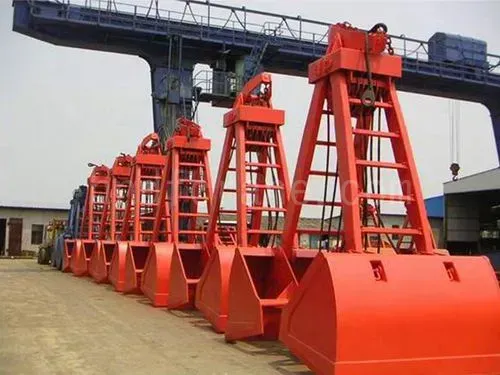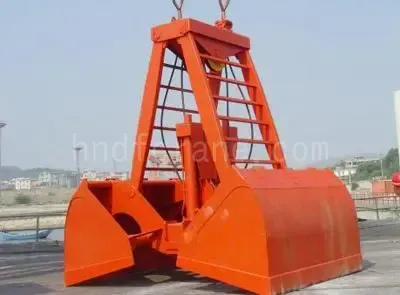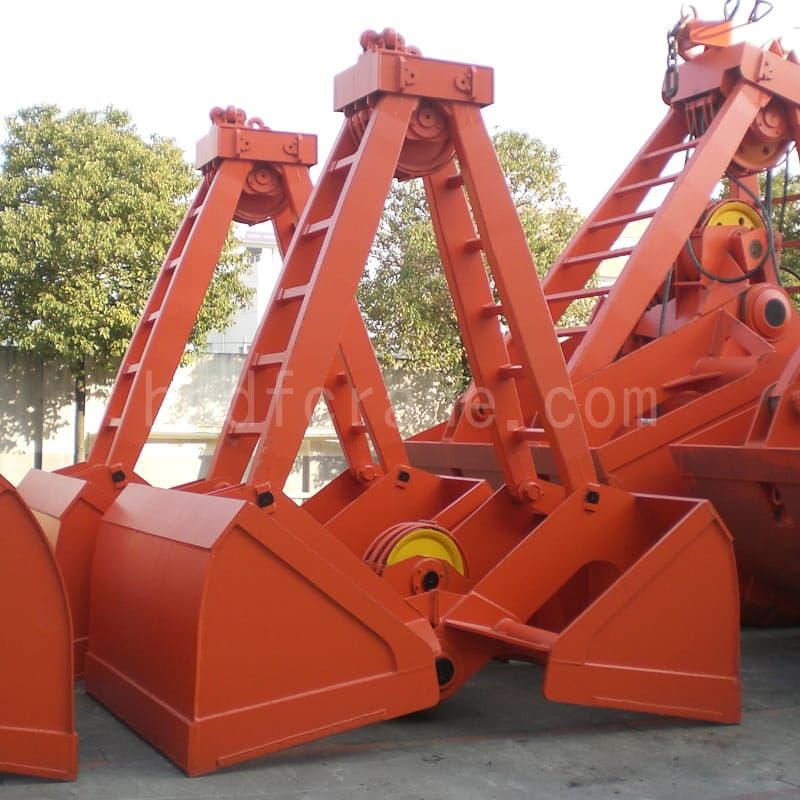Product Introduction of the mechanical two rope clamshell grabs
The mechanical two rope clamshell grabs is suitable for all kinds of cranes with double lifting device structure, and is mostly used in ports, docks, construction roads and bridges and other industries.
According to the material characteristics, it can be equipped with light, medium, heavy, and super heavy. Suitable for grabbing all kinds of loose accumulations.
Then various cranes. Equipped with two sets of motor reels (i.e. electric hoists), each set of reels leads to a wire rope, one of which serves as the support on the grab balance frame, and the other wire rope passes through the pulleys of the upper and lower beams to form a pulley block, which plays a role in the opening.
Mechanical two rope clamshell grabs are an effective tool for loading and unloading bulk cargo such as yellow sand, coal, ore powder, and bulk fertilizer in various harsh environments.
Mechanical two rope clamshell grabs has a simple structure, a novel opening and closing mechanism, easy to operate, and can accurately complete the opening and closing actions in various states.
Mechanical two rope clamshell grabs adopts a three-dimensional virtual design, and ANSYS software is used for strength analysis and verification. The weight distribution is more reasonable and the service life is longer.
The upper bearing beam of the mechanical two rope clamshell grabs are equipped with lugs, which can be directly connected to the lifting rope shackle of the crane.
Technical parameters of the mechanical two rope clamshell grabs

| Type and Size | Volume(m3) | Dead Weigh(t) | Dimensions(mm) | Sheave Dia.(mm) | Use Height(m) | Steel Rope Dia.(mm) | SWL(t) | ||||
| A | B | C | D | E | |||||||
| BS3[1.2]1.3A | 1.2(300) | 1.4(4) | 1900 | 2537 | 2488 | 2841 | 1200 | ø400 | 9 | ø17.5 | 3 |
| BS3[1.6]1.4A | 1.6(300) | 1.4(4) | 2100 | 2631 | 2559 | 3040 | 1300 | ø400 | 9.5 | ø17.5 | 3 |
| BS5[1.5]2A | 1.5(350) | 2(3) | 2000 | 2659 | 2667 | 3075 | 1260 | ø445 | 8.5 | ø19.5 | 5 |
| 2(4) | 9.8 | ||||||||||
| BS5[2]2A | 2(350) | 2(4) | 2100 | 2778 | 2818 | 3248 | 1400 | ø445 | 10 | ø19.5 | 5 |
| BS5[2.5]2A | 2.5(350) | 2(3) | 2100 | 2787 | 2715 | 3091 | 1600 | ø445 | 8.5 | ø19.5 | 5 |
| BS5[3]2A | 3(400) | 2(3) | 2300 | 3130 | 2938 | 3362 | 1650 | ø445 | 9 | ø19.5 | 5 |
| BS8[2.6]3.2A | 2.6(300) | 2.6(4) | 2300 | 3038 | 3257 | 3736 | 1800 | ø560 | 11 | ø26 | 8 |
| BS8[3]3.3A | 3(300) | 3.3(4) | 2380 | 3118 | 3287 | 3786 | 1900 | ø560 | 11.5 | ø26 | 8 |
| BS8[3.8]3.5A | 3.8(300) | 3.5(4) | 2550 | 3536 | 3286 | 3733 | 2000 | ø560 | 12 | ø26 | 8 |
| BS8[4.5]3.8A | 4.5(300) | 3.8(3) | 2500 | 3505 | 3503 | 3975 | 2300 | ø560 | 12 | ø26 | 8 |
| BS10[3]4A | 3(300) | 4(4) | 2380 | 3118 | 3287 | 3786 | 1900 | ø560 | 11.5 | ø28 | 10 |
| BS10[5]4A | 5(350) | 4(4) | 2615 | 3605 | 3503 | 3975 | 2400 | ø560 | 12 | ø28 | 10 |
| BS10[6]4A | 6(400) | 4(4) | 2800 | 3814 | 3758 | 4290 | 2150 | ø560 | 12.5 | ø28 | 10 |
| BS16[3.6]6A | 3.6(300) | 6(5) | 2500 | 3313 | 3810 | 4206 | 2100 | ø720 | 13.5 | ø32 | 16 |
| BS16[4]6A | 4(350) | 6(5) | 2500 | 3313 | 3810 | 4206 | 2200 | ø720 | 13.5 | ø32 | 16 |
| BS16[6]6A | 6(350) | 6(4) | 2900 | 3800 | 4249 | 4612 | 2400 | ø720 | 13.5 | ø32 | 16 |
| BS16[10]6A | 10(400) | 6 (3) | 3200 | 4000 | 3938 | 4673 | 2500 | ø650 | 12 | ø28 | 16 |
How to choose the right grab
- Clarify your purpose:
Before delving into the options, please clarify your specific requirements.Ask yourself:
- What materials do you want to deal with?(Logs, scrap metal, stone, etc.)
- What tasks will the grab perform?(Loading, sorting, dismantling, etc.)
- What type of device will it be connected to?(Gantry crane, overhead crane)
- What is the specific gravity of the material you grab?The number of cubes of the grab?
What is the tonnage of your crane equipped with a grab?
According to the characteristics of the material being grabbed, the grab is usually divided into four basic types: light, medium, heavy and super heavy.
| The type of material to grab | Grab material | Capacity weight(t/m³) |
| Light | Coke, slag, grains, potatoes, medium-quality anthracite lime, cement, soil, gravel, clay, broken bricks, etc. | 0.5~1.2 |
| Medium | Peat, large pieces of anthracite coal, compacted coal, clay, limestone, gravel, salt, gravel, bricks, bauxite, flakes of iron oxide, cement, sand and bricks in water, etc. | 1.2~2.0 |
| Heavy | Limestone, heavy clay, small and medium-sized ores, hard rock, rod-shaped iron oxide, iron ore, lead concentrate powder, etc. | 2.0~2.6 |
| Overweight | Large ores, large manganese ore, sedimentary agglomerated lead ore powder, etc. | 2.6~3.3 |
- Accessory compatibility: Ensure that the grab is compatible with existing equipment.
- Budget considerations: The price range of the grab is different.Balance your budget based on the function and durability of the grab.
- Comments and suggestions: Research online, read user reviews, and seek suggestions from industry peers.
- Go to the crane manufacturer for on-site inspection and testing before purchasing: test the grab under real conditions as much as possible.Evaluate its performance, ease of use, and overall functionality.
Keep in mind that choosing the right grab requires a balance between functionality, safety, and cost.By considering these fac





















































































